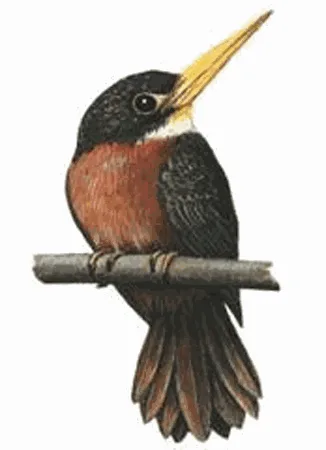
Yellow-billed Jacamar
[order] PICIFORMES | [family] Galbulidae | [latin] Galbula albirostris | [UK] Yellow-billed Jacamar | [FR] Jacamar a bec jaune | [DE] Gelbschnabel-Glanzvogel | [ES] Jacamara Piquigualdo | [NL] Geelsnavelglansvogel
Subspecies
| Genus | Species | subspecies | Breeding Range | Breeding Range 2 | Non Breeding Range |
| Galbula | albirostris | SA | n Amazonia | ||
| Galbula | albirostris | albirostris | e Colombia, Venezuela, the Guianas and n Brazil | ||
| Galbula | albirostris | chalcocephala | s Colombia, Ecuador, nw Peru and w Brazil |
Physical charateristics
Crown metallic purple, restof upperparts emerald green. Primaries dull black, outer tail black and more cinnemon towards base. Underparts pale cinnemon rufous. Female has a small white triangle at base of throat. Bill slender and pale yellow.
Listen to the sound of Yellow-billed Jacamar
[audio:http://www.aviflevoland.nl/sounddb/Y/Yellow-billed Jacamar.mp3]
Copyright remark: Most sounds derived from xeno-canto
| wingspan min.: | 0 | cm | wingspan max.: | 0 | cm |
| size min.: | 18 | cm | size max.: | 21 | cm |
| incubation min.: | 0 | days | incubation max.: | 0 | days |
| fledging min.: | 0 | days | fledging max.: | 0 | days |
| broods: | 2 | eggs min.: | 1 | ||
| eggs max.: | 3 |
Range
South America : North Amazonia
Habitat
Prefers terra firme and igapo rainforest. Found in clearings and treefall gaps. Mostly at low and medium level trees. Sometimes more open woodland or gallery forest. Absent in the coastal mangrove areas in Suriname.
Reproduction
Nests in arboreal termitaria about 1-3 meter above ground, clutch size is 2 eggs. No further data. More than 1 brood.
Feeding habits
Perches and sallies for insects. Forages in pairs or mixed flocks from exposed branches.
Conservation
This species has an extremely large range, and hence does not approach the thresholds for Vulnerable under the range size criterion (Extent of Occurrence <20,000 km2 combined with a declining or fluctuating range size, habitat extent/quality, or population size and a small number of locations or severe fragmentation). Despite the fact that the population trend appears to be decreasing, the decline is not believed to be sufficiently rapid to approach the thresholds for Vulnerable under the population trend criterion (>30% decline over ten years or three generations). The population size has not been quantified, but it is not believed to approach the thresholds for Vulnerable under the population size criterion (<10,000 mature individuals with a continuing decline estimated to be >10% in ten years or three generations, or with a specified population structure). For these reasons the species is evaluated as Least Concern.
It is found in Bolivia, Brazil, Colombia, Ecuador, French Guiana, Guyana, Peru, Suriname, and Venezuela.

Migration
Sedentary throughout range.
Distribution map

